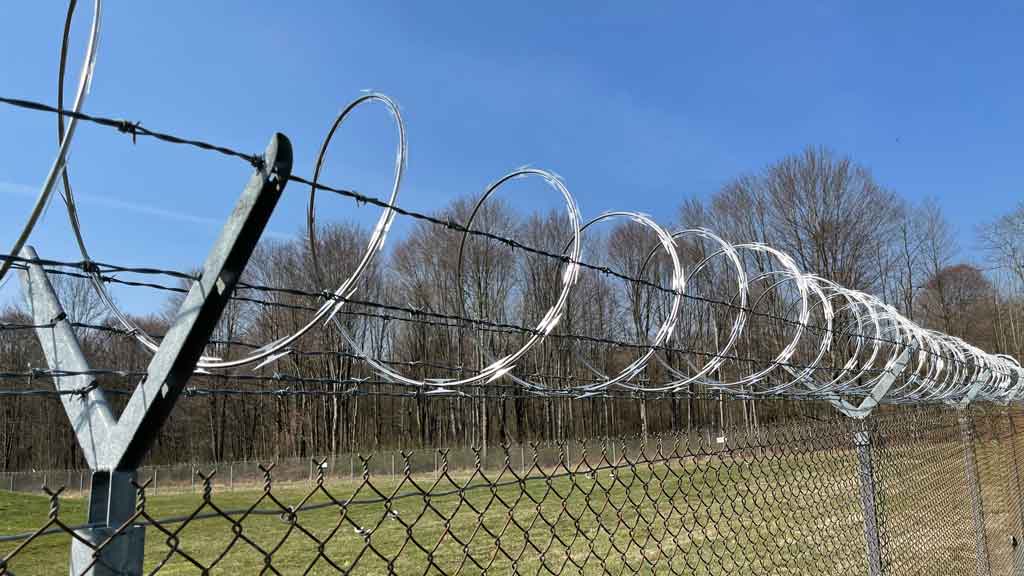Razor wire and concertina wire make a profound statement. Both are intimidating in appearance. However, they are even more effective at preventing access to areas protected by them.
Much more effective than simple barbed wire.
The intent of the sharp edges of these two styles of wire barriers is to inflict harm to their challengers. So much so that the thought alone is enough to persuade would be suiters to choose alternative routs.
What is Razor Wire?

Razor wire has coiled steel tape with thin metal strips attached to it, spaced out periodically. It is sometimes referred to as barbed tape. The strips on razor wire have sharp edges and are in the shape of a point on each side.
However, the strip itself is not sharp like a razor edge. It is the point of the strip that is extremely sharp. Much sharper than barbed wire.
Designed to rip and tear through flesh. Normally attached to the top or side of a fence, razor wire makes it extremely difficult to climb. Even more challenging than barbed wire because it is loosely installed.
Even though it is very intimidating looking, it cuts easily with basic hand tools.
Used for high security prisons and mental hospitals, it is effective for keeping people contained. Especially when hand tools used for cutting are not accessible.
Different Types of Razor Wire
There are many types and styles of razor wire. Galvanized and stainless steel are two types. Other options are the size of the coils and the length if the metal barb.
Standard coil sizes are 18″, 24″ and 36″ in diameter. Single coil is most popular. However, a double coiled version having a smaller coil inside of a larger coil is also available.
The length of the metal barb and the frequency they repeat are other options. Barbs are available from 1/2″ wide up to 2.5″ wide. For maximum deterrent the wider barb is best.
Other Types of Razor Wire
Not all razor wire comes in a coil resembling a stretched out slinky. There are other high security options like flat rings and razor fence panels.
The flat rings look like the interlocking rings of the olympics logo when installed. The fence panels have flat lengths welded together where they intersect in a diagonal pattern.
What is Concertina Wire?

Concertina wire has coiled steel wire with thin metal strips attached to it just like razor wire. It can also have twisted barbs.
However, there is one big difference. Each coil is connected to the next using connecting wires. This allows the coils to expand like an accordion.
It also allows for the wire to stand on its own when stretched out across the ground. High security prisons use concertina wire. The military also uses it for creating obstacles.
Triple concertina wire is a method of installing 3 rows in the shape of a pyramid. Having two rows on the bottom and one at the top.
As result making an impenetrable barrier. Used by the military, it has been know to even stop a tank.
Types of Concertina Wire
The same options are available for concertina wire as razor wire. Diameter of the coils and the length and spacing of the barbs or metal strips.
Coil diameters of 10″ up to 48″ are standard. Galvanized and stainless steel options are also available. Choices in materials depend on the length of time installed.
Stainless steel will be longer lasting than galvanized.

How to Install Razor Wire and Concertina Wire
A set of fence pliers or side cutters, hog rings or fence ties, and heavy duty pair of gloves is all you need to install razor wire, concertina wire or barbed tape.
I personally like to use welding gloves. The are thicker than most gloves and the length of them almost comes up to the elbow. This provides maximum protection.
Installing these intimidating wire barriers is easier than it looks. Both styles install with loose forming coils.
Stretching them tight like barbed wire allows for easier climbing. Loose wire snags easier when on the ground and doesn’t provide footholds or handhold when attached to a fence.
Razor wire and barbed tape attached to a chain link fence sits on top between “y” shaped barbed arms connected with tension or barbed wire. It can also attach to the fence fabric by using hog rings or wire fence ties.
Concertina wire can attach to a chain link fence like razor wire. However, stretching it out across the ground is another installation method. This is possible because it is self supporting.
Anchoring stakes or posts keep it secured when installed on the ground.
Final Thoughts about Razor Wire and Concertina Wire
Either type of wire barrier are effective means of protection. However, considered illegal in some cities and countries across the globe.
Especially in residential settings due to the harm they can inflict on people and animals alike. Check local building or zoning regulations before purchasing and installing razor wire or concertina wire. In location where they are prohibited, barbecue wire may be an option.
Learn more about Anti Climb Fencing here

